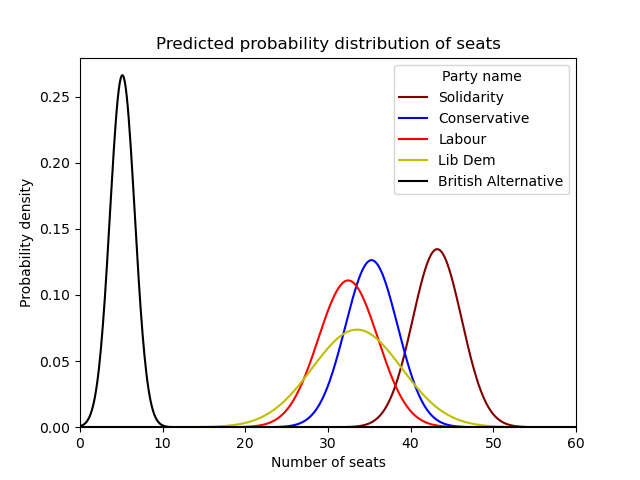Lib Dems are winning here: the Independent’s prediction of GEXXI
During the previous election, GEXX in October 2023, the Conservatives topped the poll but failed to remain in government, with Labour choosing to enter government with Solidarity and the Pirates (who have since merged into Solidarity) instead. Over the past term, the Conservatives have seen their polling drop, and Solidarity have seen their poll ratings rise. The Lib Dems, who the Greens merged into, have also seen their poll numbers rise, while Labour’s polling remained stable over the term. Will the election results continue the current trajectory of polling? We will know the definite answer to that when the results are declared, but, in the meantime, I have decided to attempt to predict the results.
The model-Independent's prediction
| Party | Previous election | Pre-election polls | Prediction | Change with previous election | Change with pre-election polls |
|---|---|---|---|---|---|
| Sol | 49 seats, 31.91% | 51 (+2) seats, 34.32% (+2.41) | (43±6) seats, (28.81±3.95)% | -6 seats, -3.1% |
-8 seats, -5.51% |
| Con | 44 seats, 29.29% | 39 (-5) seats, 25.79% (-3.5) | (35±6) seats, (23.51±4.21)% | -9 seats, -5.78% |
-4 seats, -2.28% |
| LD | 23 seats, 16.04% |
26 (+3) seats, 17.28% (+1.24) | (34±11) seats, (22.33±7.21)% | +11 seats, +6.29% |
+8 seats, +5.05% |
| Lab | 34 seats, 22.75% |
33 (-1) seats, 21.66% (-1.09) | (33±7) seats, (21.63±4.79)% | -1 seat, -1.12% |
No change in seats, -0.03% |
| Brit Alt | Didn’t exist | 1 seat, 0.63% | (5±3) seats, (3.42±2)% | New party | +4 seats, +2.79% |
| Volt | Didn’t exist | 0 seats, 0.32% | 0 seats, (0.3±0.06)% | New party | No change in seats, -0.23% |
Note: the Solidarity result for the previous election includes the Pirates, and the result for the Lib Dems includes the Greens. The prediction is a 95% confidence interval.

The clear takeaway from this prediction is that the Lib Dems are predicted to surge in seats, possibly becoming the 3rd largest or potentially even the largest party at Westminster, with the party set to perform better than in October and in the last polls carried out before the election.
Solidarity is predicted to be the largest party, a status they lost in October and regained later following the Pirates merging into the party. Solidarity is predicted to underperform its polling before the election (which predicted the party would gain seats), with the party set to have the 2nd largest loss in seats.
The Conservatives are the clear loser in this prediction. They have the largest predicted seat loss, and could drop to the 4th largest party in the Commons, ahead of only the small parties.
Labour’s result is set to be close to its polling before the election, and to its result in October. According to this prediction, the Labour leadership managed to prevent heavy losses but were unable to make large gains either, continuing the party’s trajectory of stable, stagnant polling.
There is, however, great uncertainty as to the results of the 4 large parties, as shown in the graph above which sees the probability distributions for all 4 main parties overlap.
As for the small parties, the right-wing British Alternative, which is led by model-willem (who was the leader of the Conservatives not too long ago), is set to break into Parliament, aided by a good performance in the national leaders’ debate. The pro-EU party Volt, however, is set to lose out on a seat, which would be a disappointing result for the party hoping to enter Parliament and build on its recent success in the Commons where it successfully convinced MPs to back a motion to rejoin the EU.
Who will form government?
I have examined a range of possible coalitions to see which may form following the election:
| Coalition name | Constituent parties | Seats | Size of majority |
|---|---|---|---|
| Violet | Solidarity, Labour | 76 | 2 seat majority |
| Groko | Conservative, Labour | 68 | 8 seats short of a majority |
| Broad Right | Conservative, Lib Dem, Brit Alt | 74 | 2 seats short of a majority |
| Phoenix | Lib Dem, Labour | 67 | 9 seats short of a majority |
The incumbent Violet Coalition is set to narrowly hold onto its majority, with the coalition’s majority dropping to that which the infamous Coinflip Coalition had when it formed. A coalition of all right wing parties is predicted to narrowly lose out on a majority, on the other hand. The opposite scenario, however, is within the margin of error: this election could result in the formation of a right wing coalition government. Other scenarios, such as a third Grand Coalition or a 2nd Phoenix government, are less likely to gain a majority. We will find out in a few weeks' time what coalition actually ends up forming.
How good is this prediction?
This prediction relies on some somewhat arbitrary assumptions which have been made about the election calculator, which could be correct, nearly correct, or very wrong. I have not tested my model on previous elections to see if it makes the correct assumptions. Therefore, as always with mhoc exit polls, take this prediction with a pinch of salt: it could very well be wrong. Additionally, while my predictions for the last devolved elections were accurate, this prediction is more likely to be wrong due to constituency campaigning playing a larger role in Westminster elections than in devolved elections.
